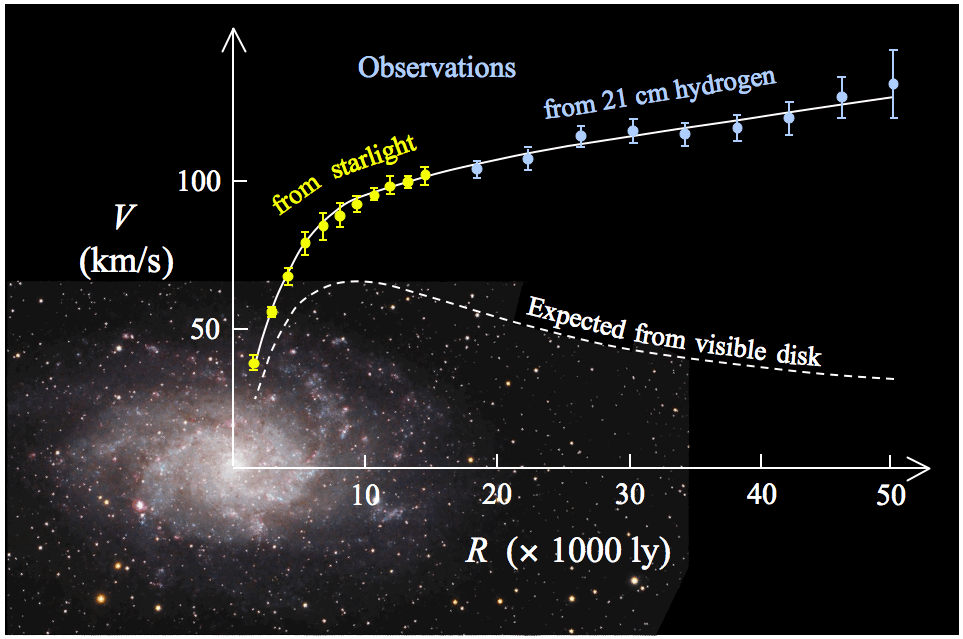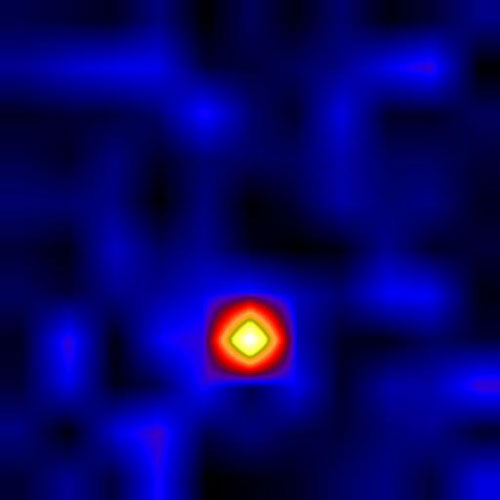Why Galactic Rotations Are So Off
A significant discrepancy exists between the rotation curve observed of galactic discs and the calculated expectations of the rotation curve.

Example of Observed vs. Expected Rotation Curve for Galaxy M33
In particular, the inner part of the disc is supposed to have a rotation velocity much greater than the outer part of the disc. What we see does not coincide with this prediction, as the velocity of rotation is observed to stay generally the same or to increase at larger radii outward.
To compensate for this discrepancy between observation and expectation, it has been concluded that there is additional unaccounted for mass that produces this variation.
However, this process of interpretation begins with a lack of understanding of black holes. It is of critical importance to this analysis that black holes are considered “singularities”. What this does is it means that the calculated distance of separation of a given portion of a galactic disc from its center of mass is a linear relationship. As a result, the inner galactic disc then is said to be very close to the galactic center whereas the outer portion is much further.
In reality, the objects that we call “black holes” are not singularities. Rather, they are so massive relative to visible light that they gravitationally bend this light from their neighboring environment so that it never reaches Earth. As a result, when we look at a black hole in the visible light spectrum we see only a gravitational anomaly. You can read more about this in my other articles, such as What Is A Black Hole?, The Truth about Black Holes, or Black Holes are Optical Illusions.
The truth of black holes lies in the x-ray light originating from their location. Due to interpretation of black holes as singularities, we have interpreted this x-ray light to come from its surroundings when, in fact, it comes from the black hole itself. In the x-ray spectrum, we are able to see the voluminous body that exists at the center of galaxies.
These objects, being so massive, gravitationally lens visible light in their proximity to give the illusion of a linear distance. In reality, there are greater and greater distances of separation in smaller observed volumes the closer that volume is to the black hole. This leads to much greater distances of separation for the inner portion of a galactic disc from the galactic center than realized.
For example, if a galactic disc is 10,000 light years wide, the inner portion may appear to be essentially zero light years from the black hole when in reality it is, say, 10,000 light years from the black hole. When the actual radius is so drastically different from the approximated radius (as a result of not accounting for gravitational lensing), then the calculations are massively inaccurate.
This leads to substantially smaller ratios of the distance of separation of the inner and outer portions of a galactic disc from its center. What may be "100 lightyears vs. 50,000" (see M33 Figure above)--the outer portion being said to be 500 times as far away as the inner portion--may actually be more like 50,000 vs. 100,000--the outer portion, then, being only twice as far away even though the same separation exists between the inner and outer portion. We would never be surprised to see similar velocities of bodies in the inner (30 AU from the sun) and outer (55 AU from the sun) portions of the Kuiper belt of our solar system, yet because black holes are so misunderstood we look to a galaxy’s equivalent belt’s motions and find them perplexing. This all stems from the lack of understanding of black holes.
Dark Matter
This is not to say that "dark matter" does not exist; of course it exists. The universe is infinite, having ever larger and ever smaller particles than those closest to our environment (atoms, for reference point). However, the actual radius of a galactic disc of a given galaxy from its central black hole is always going to require recognition of this additional inner volume that is hidden by gravity in order to determine actual radii from the center, which in turn is necessary understanding in order to accurately interpret and model galactic disc rotation curves that are a function of radius.
For More Information
This was a cursory writing built upon an extensive framework that is well documented throughout my other articles here on Steemit. Feel free to browse through these articles or check out my website CascadingUniverse.Org, or read my book or research paper or watch my video explanation.
Recommended:
The Big Bang's Big Assumption--Explains how gravitational redshift causes redshift per distance observations and how gravity causes electromagnetism.
Thanks for reading!
Steve Scully
